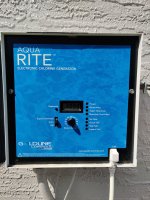- Oct 1, 2021
- 9
- Pool Size
- 11500
- Surface
- Plaster
- Chlorine
- Salt Water Generator
- SWG Type
- Hayward Aqua Rite (T-3)
Hello! My Aqua Rite system has stopped generating chlorine. The T-3 cell is clean and tested good at the pool store.
Device readings:
Salt: 3100 (recently recalibrated)
Temp: 91 (pool thermo says 88)
Volts 27.3 / 27.0
Amps 2.57 / 2.63
Output 100% (usually ~30% but turned up to try to generate)
Instant -2500 / -2700
AL-3
R 1.50
T-3
Pool store test results:
Free Chl 0.77
Total Chl 0.86
pH: 7.8
Alk: 104
Calcium: 400
Cya: 53
Iron: 0.1
Copper: 0.1
Phos: 0
Salt: 3000
I opened the box and no obvious signs of component failure; 240V line and transformer voltages look good. I'm at a loss as to why it's not generating. One odd thing is the AL-3. I'm not sure I remember it being different, but when I looked it up (here of TFP) I see AL-3 is SmartPure - but my system is a Goldline / Hayward Aqua Rite AQR (see photo). Could that be an indicator of a firmware issue? Appreciate any thoughts on cause and fix, or pointers for further troubleshooting. Thank you!
Device readings:
Salt: 3100 (recently recalibrated)
Temp: 91 (pool thermo says 88)
Volts 27.3 / 27.0
Amps 2.57 / 2.63
Output 100% (usually ~30% but turned up to try to generate)
Instant -2500 / -2700
AL-3
R 1.50
T-3
Pool store test results:
Free Chl 0.77
Total Chl 0.86
pH: 7.8
Alk: 104
Calcium: 400
Cya: 53
Iron: 0.1
Copper: 0.1
Phos: 0
Salt: 3000
I opened the box and no obvious signs of component failure; 240V line and transformer voltages look good. I'm at a loss as to why it's not generating. One odd thing is the AL-3. I'm not sure I remember it being different, but when I looked it up (here of TFP) I see AL-3 is SmartPure - but my system is a Goldline / Hayward Aqua Rite AQR (see photo). Could that be an indicator of a firmware issue? Appreciate any thoughts on cause and fix, or pointers for further troubleshooting. Thank you!


